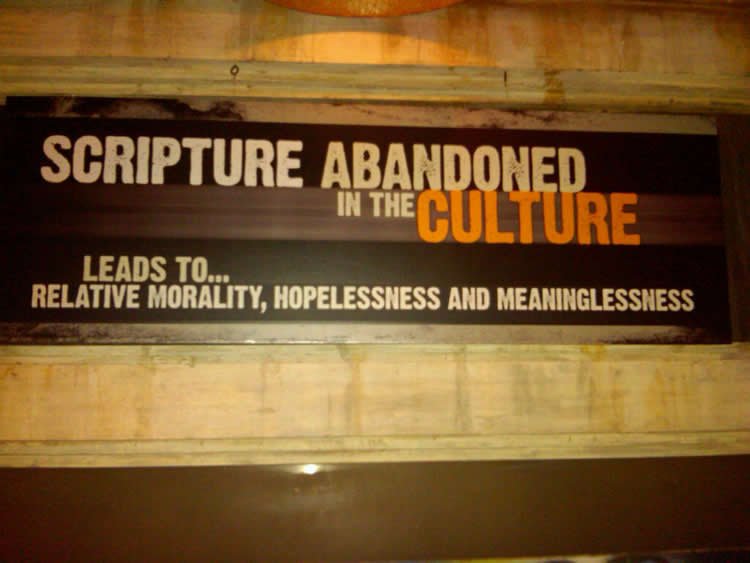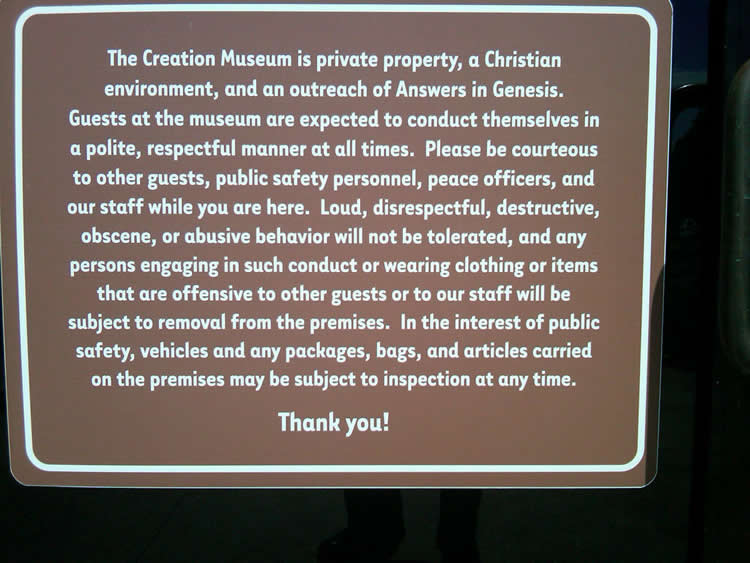
Live(ly) Science Debate
When the museum is grossly misrepresented on a prominent website, it prompts us to respond quickly with a public rebuttal like this one.
We are used to evolutionists criticizing the content of our Creation Museum (though we often get high marks for quality of presentation). But when the museum is grossly misrepresented on a prominent website, it prompts us to respond quickly with a public rebuttal like this one. “Disagree with our position if you wish, but get your facts straight” is now becoming an increasing plea from Answers in Genesis as we are interviewed by the electronic media (and other media outlets).
An especially egregious example of bad reporting on the Creation Museum occurred yesterday when a commentary appeared on LiveScience.com. According to Alexa.com, it is a well-trafficked website that ranks an impressive number—6,700 out of millions of websites worldwide. For several hours Wednesday, LiveScience’s Creation Museum review was the lead article on its list of “Top Stories” (you may see the article on their website). The piece has also appeared on the popular Yahoo News website.
With this rebuttal, we will examine and dissect the major contentions found in the LiveScience commentary and expose a few of its misrepresentations; tomorrow, we will post a more detailed point-by-point rebuttal.
The LiveScience commentary essentially summarized a study by Bernadette Barton of Morehead State University in Kentucky. Barton has brought student groups on field trips to the museum and reported on their experiences (which included their fear that they might be asked to leave the museum if they ever revealed themselves to be non-Christians).
The Alleged Consequences of Rejecting a Young Earth
The LiveScience commentator falsely declares that an exhibit in the Creation Museum “purports to show what happens when mankind abandons Young Earth Creationism” and that the “consequences include the birth control pill, abortion, divorce, murder and gay marriage.”
However, this is what the museum exhibit really says:

From Graffiti Alley in the Creation Museum
The sign clearly declares what will occur in a society that rejects the authority of the Bible and its teachings. Without God’s Word, people will set their own standards of conduct (humanism). Actually, opposition to the Bible’s teaching of an earth that is thousands of years old is merely a symptom of rejecting God and His Word; the earth’s age does not cause social ills. By the way, from the atheistic evolutionists’ viewpoint, why is murder even wrong in their purposelessness and mindless universe that has no absolute standards? In fact, in that context, what moral weight does the LiveScience commentary carry when it rebukes our views and says we are wrong?
Is the Museum an Uncomfortable Place?
The general theme of the LiveScience commentary is a contention that many guests will be uncomfortable walking through the museum. The writer indicates that when Barton has brought students to the museum, some of the young people have found the “visit unsettling,” “were on edge at the museum,” and their experience was “particularly nerve-wracking.” Furthermore, there is the bizarre contention that “the students felt they might accidentally reveal themselves as nonbelievers and be asked to leave.” It certainly seems the students were already prepared to be uncomfortable before they ever arrived at the museum.
This claim is preposterous, of course. We have hosted atheist/agnostic groups as large as 285 people in one day; some of the atheists were disruptive, but only one person was asked to leave (see Ken Ham’s blog post on this subject). We sincerely want skeptics to visit; it’s only those who are continually disruptive for our other museum guests who are asked to leave. (We can go many months without having to ask a disruptive skeptic to leave.) The Creation Museum genuinely seeks to have non-Christians to take a tour, and especially have them view the powerful Last Adam film towards the end of the museum tour and hear the gospel presented. At its heart, the museum is evangelistic, and thus the last thing we want to see is atheists and other skeptics leaving the museum. At the Creation Museum, we are always mindful of the verse that declares that God is “not willing that any should perish, but that all should come to repentance” (2 Peter 3:9). The museum exists to present the saving gospel message, and since atheists will most likely not attend a church where the gospel is preached, we want them to come to the Creation Museum. The claim that students “might accidentally reveal themselves as nonbelievers and be asked to leave” is bizarre.
Also, there is no “compulsory Christianity” (i.e., pressure to accept our views) occurring inside the museum, as claimed by Barton and LiveScience. Of course, guests come here of their own freewill, and nobody is forcing them to read all the exhibits and watch the videos. Furthermore, we have heard comments time and time again (even from our detractors) that this is a family-friendly, cordial place, and that the museum is not an evolution-bashing center. Some anti-creationists say we present the evolutionary arguments fairly (as we also refute them), and offer them in a professional way (e.g., see an article on the popular website of Salon.com).
The LiveScience comment that “people who don't ascribe to fundamentalism often report the need to hide their thoughts for fear of being judged or snubbed” needs to be exposed for its irony. Our nation is filled with secular universities, science museums, and media outlets that will insist they are not religious, but in reality present a worldview/religion of secular humanism and in so doing also ridicule Christianity. When creationist students go to school and are taught the religion of secular humanism, would this reporter acknowledge the possibility that these young people could be uncomfortable?
We recognize that some visitors will feel somewhat uncomfortable being in a place that disagrees with their closely held worldview, even if it’s presented in a respectful way as it is here. We also acknowledge that as the gospel is presented in the museum, especially in the Last Adam theater, it will challenge people to accept the claims of Christ—that He is Creator, Savior, and Lord (Colossians 1). That is a message that can be convicting, but it is presented out of love and concern, and not in an aggressive way.
The writer also made a big issue about signs at the museum concerning guest behavior. They were posted in 2009 because of constant threats by atheist bloggers that they were intending to visit the museum and be disruptive. Today, it is not unusual for museums to display such cautionary signs, and some museums search all the bags of each arriving guest.

Education and Evolution
The writer’s statement that “debates about creationism usually revolve around education” is an apparent reference to the recent efforts of some people in the Intelligent Design movement that introduces alternative ideas to evolution in public school science classes. Apparently, the writer sees the Creation Museum as a backdoor attempt to get creationism presented to unsuspecting school children who will visit—now that federal courts have virtually allowed evolution to go unquestioned in public schools (see Can Evolution Be Criticized in Public Schools?). For its part, Answers in Genesis/Creation Museum is not a part of the ID movement (though we use some of the same arguments, especially about the clear design we observe in nature); furthermore, we have stated many times (even well before the museum was on the drawing board) that we believe it is unwise to mandate that creation be taught in public schools, as the outcome would largely be counterproductive (i.e., instructors who believe in evolution would teach creation in a negative way).
What is the Museum Really About?
It is a gross misrepresentation of our museum’s purpose when the writer declared that it is “devoted” to a message of proclaiming a young earth. In reality, the Creation Museum is all about the authority of the Bible—from Genesis to Revelation—and that’s what guests learn as they take their “walk-through history” according to the Scriptures. Dr. Jason Lisle, the director of the museum’s planetarium and AiG’s staff astrophysicist, was quoted in the LiveScience piece, and clearly told the reporter that the purpose of the museum was to share with visitors that the Bible is true—beginning with Genesis. For the commentator to write that the museum is “devoted” primarily to a young earth would be akin to saying that LiveScience mostly exists to attack creationists.
Also, the reporter’s use of the word “fundamentalist” to describe our museum is a loaded term, one that has lost its original, legitimate meaning (see its definition here). It is now a term of derision to signify any extreme religious movement (e.g., fundamentalist, extremist Islam). When almost half of Americans agree with the statement that “God created humans pretty much in their present form either exactly as the Bible describes it or within the last 10,000 years”, we are not out of the mainstream (see Sliding Down the Polls).
Thankfully, the writer managed to acknowledge that “not every visitor to the museum comes away with the same feelings as Barton and her group. In 2007, University of South Dakota earth scientist Timothy Heaton visited the museum and described its portrayal of evolution as ‘respectful,’ if not accurate.”
Ultimately, the LiveScience commentary and the Barton study are attacks on Christianity as a whole. The Creation Museum stands for the biblical authority of the Christian faith, and it appears that the writer has used her commentary as an attempt to undermine that authority. A commentary like this, which borders on hysteria, begs the question: why are so many evolutionists very concerned about one museum compared to the several dozen science museums across the country that proclaim a contrary evolutionary worldview to millions of visitors each year?
Our publicists shared with us their belief that the commentary was a case of a writer having her article largely composed before we were contacted. Furthermore, this person who called our publicists to arrange an interview with Dr. Lisle stated that the premise of her article—and hence her desire to speak with Dr. Lisle—was to discuss “how open the museum was to people who didn’t share the same beliefs, how willing we are to engage in debate, etc. She hid the full purpose of the interview.” Another person in that publicist’s office observed that the commentary “demonized AiG and the museum with labels that trigger fear in the hearts of their readers. It is an example of ‘ready, fire, aim’ . . . and then do the research.”
It is surprising that a “senior writer” for a prominent website could ever write such a poorly researched piece. Now, some of the writer’s observations may have been taken directly from the research of the Morehead instructor (the full study is still to be released), but some of her own comments are clear misrepresentations of what is presented inside the museum. This shabby “research” should be exposed. As a former college instructor, I would not have tolerated such poor research from a student and would have issued a low or failing grade.
Unfortunately, the article’s non-Christian readers may think twice about visiting a supposedly “uncomfortable” place. By not touring, they may never receive a full treatment anywhere else of the wonderful teaching that the Bible is true—including its gospel message.
Tomorrow, we will offer a more detailed rebuttal of this poor LiveScience commentary.

Answers in Genesis is an apologetics ministry, dedicated to helping Christians defend their faith and proclaim the good news of Jesus Christ.
- Customer Service 800.778.3390
- Available Monday–Friday | 9 AM–5 PM ET
- © 2025 Answers in Genesis
